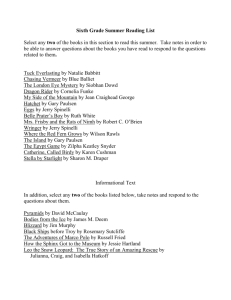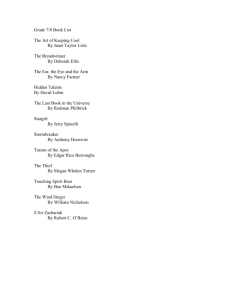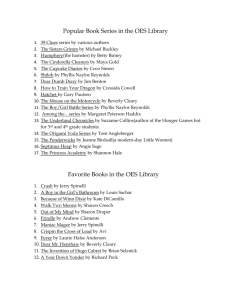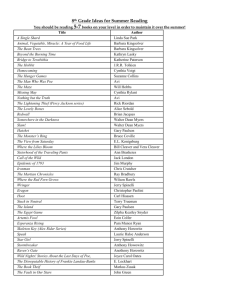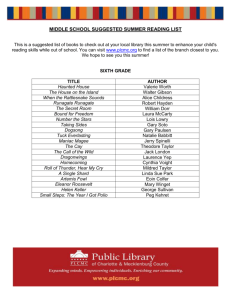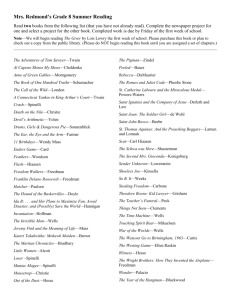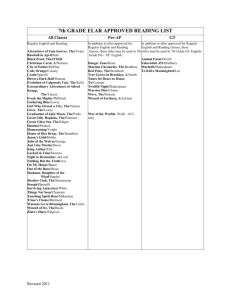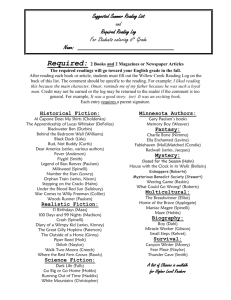Designing the house of knowledge in 18th
advertisement
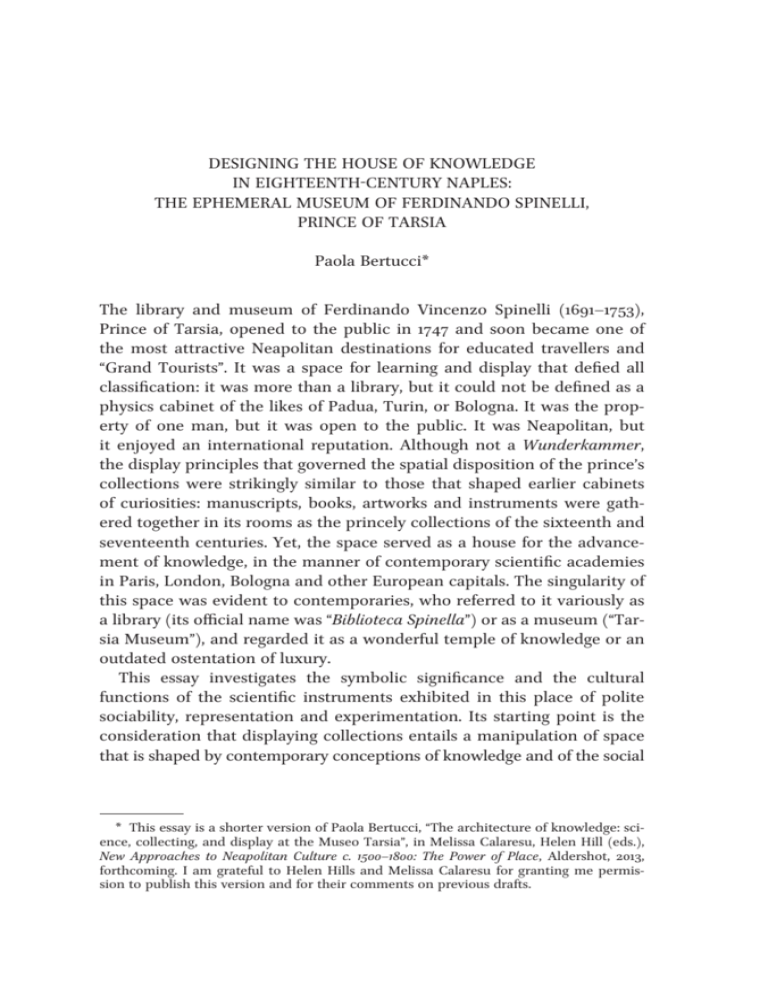
DESIGNING THE HOUSE OF KNOWLEDGE IN EIGHTEENTH-CENTURY NAPLES: THE EPHEMERAL MUSEUM OF FERDINANDO SPINELLI, PRINCE OF TARSIA Paola Bertucci* The library and museum of Ferdinando Vincenzo Spinelli (1691–1753), Prince of Tarsia, opened to the public in 1747 and soon became one of the most attractive Neapolitan destinations for educated travellers and “Grand Tourists”. It was a space for learning and display that defied all classification: it was more than a library, but it could not be defined as a physics cabinet of the likes of Padua, Turin, or Bologna. It was the property of one man, but it was open to the public. It was Neapolitan, but it enjoyed an international reputation. Although not a Wunderkammer, the display principles that governed the spatial disposition of the prince’s collections were strikingly similar to those that shaped earlier cabinets of curiosities: manuscripts, books, artworks and instruments were gathered together in its rooms as the princely collections of the sixteenth and seventeenth centuries. Yet, the space served as a house for the advancement of knowledge, in the manner of contemporary scientific academies in Paris, London, Bologna and other European capitals. The singularity of this space was evident to contemporaries, who referred to it variously as a library (its official name was “Biblioteca Spinella”) or as a museum (“Tarsia Museum”), and regarded it as a wonderful temple of knowledge or an outdated ostentation of luxury. This essay investigates the symbolic significance and the cultural functions of the scientific instruments exhibited in this place of polite sociability, representation and experimentation. Its starting point is the consideration that displaying collections entails a manipulation of space that is shaped by contemporary conceptions of knowledge and of the social * This essay is a shorter version of Paola Bertucci, “The architecture of knowledge: science, collecting, and display at the Museo Tarsia”, in Melissa Calaresu, Helen Hill (eds.), New Approaches to Neapolitan Culture c. 1500–1800: The Power of Place, Aldershot, 2013, forthcoming. I am grateful to Helen Hills and Melissa Calaresu for granting me permission to publish this version and for their comments on previous drafts. 120 paola bertucci functions it should serve. However, the analysis that I offer here moves beyond the notion of the museum as a space for the representation of knowledge. I show that the Tarsia Museum was also a space for cultural experimentation and self-promotion. By analysing its vicissitudes, I wish to point to the tensions arising from contrasting visions of the museum as a space of representation and as a space of knowledge production. Architecture of Display Palazzo Tarsia was designed by the most celebrated Neapolitan architect, Domenico Antonio Vaccaro, upon the commission of Ferdinando Vincenzo Spinelli, Prince of Tarsia.1 As Knights of Malta since the seventeenth century, and marquises of the Holy Roman Empire, the Spinelli were one of the wealthiest and most powerful families in Naples. The building of the Palazzo absorbed Spinelli for decades. He began to invest in the project in the 1730s and died before it was finished. The prince worked closely with Vaccaro in the process of designing the building and in the supervision of a constellation of artists, artisans and skilled labourers selected from among the best Naples had to offer. Ambitious as it was, Palazzo Tarsia was never completed. The data offered by architectural evidence and archival records are fragmented, yet an engraving by Antonio Baldi on Vaccaro’s design offers an extraordinary – if virtual – vision of the project in all its magnificence (Fig. 1). By a clever alteration of the perspective, the engraving exalts the sense of splendour and architectural grandeur that Spinelli wanted his palace to materialize. It presents a bird’s eye view of the Palazzo, complete with annexes, gardens and decorations, most of which were still to be built at the time of publication (1737). Vaccaro’s print was an exquisite manifesto of the prince’s political and cultural ambitions. It is no accident that Spinelli commissioned it from Vaccaro in 1735, the year of the crowning of the Bourbon King Charles. Until then, Naples had been a province under the viceroys, with no king 1 Several recent works have discussed Palazzo Tarsia from the perspective of the history of art, history of architecture and the history of libraries, but they have only quickly mentioned Spinelli’s collection of scientific instruments: Vincenzo Rizzo, Ferdinando Spinelli di Tarsia. Un principe napoletano di respiro europeo (1685–1753), Aversa, 1997; Elena Manzo, La merveille dei principi Spinelli di Tarsia: Architettura e artificio a Pontecorvo, Naples, 1997; Vincenzo Trombetta, Storia e cultura delle biblioteche napoletane: Librerie private, istituzioni francesi e borboniche, strutture postunitarie, Naples, 2002. the ephemeral museum of ferdinando spinelli 121 Fig. 1. Domenico Antonio Vaccaro, Prospetto del Gran Palazzo di Sua Eccellenza il Principe di Tarsia (Courtesy of the Biblioteca Napoletana di Storia Patria). living in the city. Charles’s decision to settle in Naples aroused great hopes of cultural rebirth amongst the local nobility and marked a significant change in the city’s cultural life: in the span of a few years the king promoted the reorganization of the university system and the digging of the archaeological site of Herculaneum, founded new academies and opened the San Carlo theatre.2 The sparkling renovation of Palazzo Tarsia constituted an astounding example of the enthusiasm that the arrival of the king excited in the Neapolitan aristocracy. It was a material expression of support for the Bourbon rule on the part of a family that had a ­centuries-old history of royal connections. In 1738 Spinelli became a member of the Reale Ordine di San Gennaro, a knightly order instituted the same year by King Charles. The knighthood was granted to a selected elite of local aristocrats particularly faithful to the monarchy, who obtained various religious and civil privileges. The fact that Spinelli was selected to be among the first members of the order testifies to the success of his efforts to signal his support of the Bourbon rule. 2 Raffaele Ajello, “La vita politica napoletana sotto Carlo di Borbone”, in Luigi Labruna (ed.), Storia di Napoli, Naples, 1971–1978, 10 vols.; v. 7, pp. 961–984. 122 paola bertucci Palazzo Tarsia was a celebration of the prince’s position in Neapolitan society and of his support of the new king. The architecture of aristocratic residences materialized social hierarchy and notions of power both by displaying the symbols of eminence and rank and by allowing selective access to the various areas of the estate.3 Spinelli and Vaccaro designed the Palazzo as a marvel of nature and art, where luxury, imagination, knowledge and technical skills were conjured together to overwhelm visitors with a sense of victory over limits and constraints. Its location in the Pontecorvo, an area recently taken up by local aristocrats, offered breathtaking views of the Gulf of Naples and Mount Vesuvius. While admiring the valuable collection of paintings in sumptuous reception rooms, the prince’s most illustrious guests would simultaneously enjoy the most emblematic vistas of the city.4 The prince devoted a large section of his palace to learning and display in a series of rooms that than came to be called the “Biblioteca Spinella” or “Tarsia Museum”, in which he placed books, artworks and scientific instruments.5 It was the fame and reputation of this museum and library, open to the public three times a week, that made Palazzo Tarsia renowned in the republic of letters and a destination for Grand tourists and learned travellers arriving in Naples. The Temple of Minerva in Naples The Biblioteca Spinella corresponded in significant ways to the ideal library described by Gabriel Naudé, Cardinal Mazarin’s librarian, in his Advice on establishing a library.6 As the “Biblioteca Spinella”, the library of Palazzo Tarsia blended its name and reputation with that of its owner. It had an 3 Norbert Elias, The Court Society, New York, 1983; Chandra Mukerji, Territorial ambitions and the gardens of Versailles, Cambridge, 1997; Gérard Labrot, Palazzi napoletani: Storie di nobili e cortigiani, Naples, 1993. 4 Spinelli owned an impressive collection of paintings, which included works by Giotto, Raphael, Titian, Michelangelo, Andrea del Sarto, Veronese, Caravaggio, Carracci, Rubens, Van Dyck, Guido Reni, Tintoretto among many others. For a full list of painters, see Carlo Celano, Delle notize del bello, dell’antico, e del curioso della città di Napoli per li signori forastieri, Naples, 1792, 4th ed., 10 vols.; v. 6, pp. 61–62. 5 According to Vaccaro’s captions in the engraving of Palazzo Tarsia, the library was 138 × 46 Neapolitan palmi (approximately 36 x 12 meters). This contrasts with the larger measurements recorded in later descriptions of the actual library (Vaccaro’s was a project), which I will use in the remaining of the paper. This might indicate that the library – and the collection of instruments – acquired more importance as the building progressed. 6 Gabriel Naudé, Advis pour dresser une bibliothèque, Paris, 1644. the ephemeral museum of ferdinando spinelli 123 independent entrance, which distinguished readers and visitors from the prince’s guests, and it was composed of four rooms detached from the palace’s main body, with two galleries that overlooked the beautiful gardens. The prince spared no financial outlay in making his library pleasant to the eye. He spent considerably on indorature, the gilding that coated all the banisters, frames, stuccoes and other decorative elements in the Palazzo. The noblest metal, symbol of opulence and prosperity, was also deployed generously on the leather bindings of books and on the carved cabinets that housed them. Indeed, the abundance of gilding in the library was dazzling and, in contemporary descriptions, became one of its most striking features. The list of expenses that the prince sustained reveals his desire to spare nothing to produce a magnificent house of knowledge, for the cultivation of science, culture and the arts.7 It was to be a library as well as a “museum”, in the literal sense of a temple of the muses, where the learned would find inspiration. The heterogeneity of the items displayed in the Biblioteca Spinella reminded contemporaries of the collections of the Medici in Florence, where objects of art and objects of science ­coexisted.8 However, the Tarsia Museum was not simply the product of a collecting activity guided by learned curiosity, nor was it simply a display of connoisseurship styled upon earlier princely cabinets or Wunderkammern. Instead, Ferdinando Spinelli entrusted the gathering of books and of scientific instruments to local dealers and scholars, some of whom furnished him with pre-existing book collections.9 He purchased a valuable collection of seventeenth-century mathematical instruments from the bookseller Porcelli and commissioned from a Dutch instrument-maker, most probably Pieter van Musschenbroek, the manufacture of several physics instruments for experimental demonstrations.10 More than simply representing Spinelli’s involvement in culture, his library and museum were a statement about his intention to create in Naples a space where cultural activities could be carried out under his (and the king’s) patronage. Ideal architectural structures were often invoked in early-modern writings on human learning. In the seventeenth century, the biblical images of the garden, the ark, the tower and the temple were commonly referred 7 Rizzo, op. cit. (n. 1). 8 Gherardo Degli Angioli (De Angelis), Orazioni. Parte I, Naples, 4th ed. 1763, pp. 276–277. 9 Trombetta, op. cit. (n. 1), pp. 100–102. 10 Rizzo, op. cit. (n. 1), p. 109. 124 paola bertucci to as metaphors of knowledge.11 Spinelli resorted to classical imagery: in the wake of the enthusiasm for the ancient roots of Naples, triggered by the digging of Herculaneum, he designed his museum and library as the Temple of Minerva – the goddess of knowledge born from Jupiter’s brain.12 An epigram composed by the philosopher Giambattista Vico, engraved in gold above the entrance door, greeted visitors to the Temple, sealing the relationship between knowledge and power that the Biblioteca Spinella materialized: “Born in heaven from Jupiter’s brain, Minerva / Dwells here on earth in golden shelters worthy of Jupiter”.13 Minerva was the learned offspring of the most powerful of the gods. Her sacred abode on earth was a site that invited the respectful celebration of ancient cultures and called for the advancement of knowledge. Similar to Francis Bacon’s House of Solomon, the Temple of Minerva was a site for observation, learning and experiment, yet it did not exist on Bacon’s imaginary Bensalem, but in the flourishing Bourbon city of Naples. It was there that learned élites could now find a new patron for the sciences and the arts. The Biblioteca Spinella was simultaneously a Neapolitan object and a cosmopolitan place. It represented the prince’s vision of a centre of learned sociability that connected Naples to other European cultural capitals, under the aegis of the Spinelli family and of the Bourbon dynasty. Whether travellers or scholars, visitors who entered the Tarsia Museum and Library walked through a series of rooms that represented to them the position of Ferdinando Spinelli and his family in the cultural history of Naples and the central role that the new site of knowledge would play in the cultural awakening to follow the arrival of the Bourbon king. The library’s first, and largest, room housed Latin, Greek and Italian books mostly bound in Neapolitan style.14 The portrait of Ferdinando Spinelli was hung in a central position above its main door, reminding readers who entered through the independent entrance that the Temple of Minerva was part of Palazzo Tarsia. At the opposite end of the room, facing Ferdinando’s portrait, hung that of his father, whose book 11 Jim A. Bennett, Scott Mandelbrote, The Garden, the Ark, the Tower, the Temple: Biblical Metaphors of Knowledge in Early Modern Europe, Oxford, 1998. 12 On antiquarianism in eighteenth-century Naples see the special issue “Antiquarianism, museum, and cultural heritage. Collecting and its contexts in eighteenth-century Naples”, Journal of the history of collections 19 (2007). 13 Placido Troyli, Istoria Generale del Reame di Napoli, Naples, 1752, p. 141. My translation. 14 Ibid. According to Celano, this room was 120 × 40 Neapolitan palmi (approximately 31.1 × 10.5 meters): Celano, op. cit. (n. 4), v. 6, pp. 70–72. the ephemeral museum of ferdinando spinelli 125 c­ ollection constituted the original core of the library. The prince used portraits of himself and his family to situate the Temple of Minerva within the Spinelli family’s cultural patronage in Naples. Marble statues of each of the four seasons standing in the room’s four corners, reminded visitors of the course of time, which culminated with Naples’ alliance with the Spanish crown. Such alliance was materially represented by a remarkable pyramidal cabinet designed especially by local artisans, placed at the centre of the room. Made of ebony, turtle shell and gold-plated copper, this quintessential symbol of hierarchy and power stood upon a carved gilt pedestal and was crowned by a double clock that gave Italian and Spanish time.15 Two armed loadstones, symbols of the force of attraction that draws people together, were placed on the sides of the pyramid, which served as a display case for an exquisite collection of seventeenthcentury mathematical instruments made by the French instrumentmaker Nicholas Blondeau.16 The collection (that included gold and silver items) had belonged to a previous Neapolitan collector who had sold it to Porcelli, for re-sale. It was unusual for eighteenth-century collectors to display historical instruments, and contemporary descriptions of the Tarsia Museum did not fail to emphasise the fine craftsmanship of “the distinguished and famous Blondon”.17 In placing it at the centre of the main room in an attractive display case, Spinelli set the scientific activities of the museum in continuity with previous local traditions. Along the corridor, visitors could admire a terrestrial and a celestial globe made by Vincenzo Coronelli. Other expensive astronomical instruments, such as a valuable astronomical quadrant, signed by the English maker Sisson, and a semicircle with telescopic sights, were also on display in this room. This was probably on a temporary basis only, as according to Vaccaro’s drawing a “noble and decorated observatory” was to crown the entire palace 15 The clock was made by two English clockmakers who worked for the prince, Oliver Robinson and Charles Tredman. See Rizzo, op. cit. (n. 1), p. 10. 16 Blondeau was a French maker who moved to Milan in the late seventeenth century and operated in Naples around 1694. I am grateful to Anthony Turner who helped me identify in Nicholas Blondeau the otherwise unknown Nicola Blondone or Blondel mentioned in eighteenth-century descriptions of the Biblioteca Spinella. It is likely that an existing sector signed “Blondeau, Naples” made in 1694 was among the instruments purchased by the prince of Tarsia from Porcelli. 17 Troyli, op. cit. (n. 13), p. 241. On eighteenth-century collectors’ preference for new instruments, see Anthony J. Turner, “From mathematical practice to the history of science”, Journal of the history of collections 7 (1995), pp. 135–150. 126 paola bertucci (Fig. 1, letter Q).18 When the French astronomer Jerôme de Lalande visited Palazzo Tarsia in 1766, however, he described its astronomical instruments, but did not mention an observatory.19 It is likely that the death of the prince in 1753 prevented the completion of this project. Indeed, no description of the observatory exists. The library’s second room was dedicated to foreign cultures. It held foreign books with French bindings, and its central piece was an English orrery that could be modified to illustrate the geocentric system.20 A series of portraits of the Spinelli princes, arranged according to their genealogy starting with their tenth-century progenitor, decorated the walls around the orrery. Above the door leading to the next room an epigraph engraved in gold letters on “touchstone” glorified Ferdinando Spinelli for making his collections available to the public. Access to the working areas of the library implied an obliged choreography through these two rooms, in which knowledge was represented as emanating from Spinelli’s munificence. Readers had no other way to reach the reading room, where they could sit on chairs covered with crimson silk embroidered with gold, and work on Chinese desks coated with black leather and gilded decorations. Here, portraits of illustrious men hung from the walls. Between the reading room and the physics cabinet (the fourth room) there was a gallery where two local savants, the astronomer Felice Sabatelli and the naturalist Giovanni Maria Della Torre, built a meridian line modelled on those made by Gian Domenico Cassini for the Church of San Petronio in Bologna and by Francesco Bianchini for the Church of Santa Maria degli Angeli in Rome. The works for the meridian, according to an epigraph engraved in it, started in 1749 and were ­completed in 1759.21 18 It should be noted that the observatory in Vaccaro’s design seems more an idealization than a realistic project. See Troyli, op. cit. (n. 13), p. 241, and Tommaso Di Costanzo, Ferdinandi Vincentii Spinellii Tarsiae principis bibliothecae index alphabeticus secundum authorum cognomina dispositus, Naples, 1780, p. 128. Troyli erroneously describes the quadrant as a Dutch instrument, and lists also an electrical machine in this room, which appears in the second room in Di Costanzo’s inventory. The differences maybe due to the different dates of publication. 19 Joseph-Jérôme de Lalande, Voyage d’ un François en Italie, Fait dans les années 1765 et 1766, Paris, 1769, 8 vols.; v. 6, pp. 199–200. The observatory is not mentioned in later revised editions of this work either. 20 Troyli, op. cit. (n. 13), p. 141. According to Celano this room was 50 × 20 palmi (approximately 13 × 5.2 meters): Celano, op. cit. (n. 4), v. 6, pp. 61–68. 21 Troyli, op. cit. (n. 13), p. 141. On meridians, see John Heilbron, The Sun in the Church: Cathedrals as Observatories, Cambridge (Massachusetts), 1999. the ephemeral museum of ferdinando spinelli 127 The gallery marked the transition from spaces of study (reading room) and display (first two rooms) to one of exhibition and performance: the physics cabinet. In this room, which hosted the collection of philosophical instruments, the prince and his guests enjoyed the spectacle of experiments. Spinelli owned the most representative machines of experimental philosophy, covering all branches of mid-eighteenth-century experimental philosophy: mechanics, astronomy, optics, electricity, magnetism, hydrostatics and pneumatics.22 In line with the international character of contemporary science, the instruments came from a variety of places. Most of them were made in the famous workshop of Jan van Musschenbroek, the Dutch instrument maker who furnished the physics cabinets of the University of Padua and of the Istituto delle Science in Bologna. A few items carried the signature of renowned English makers and others were manufactured locally.23 The cosmopolitan nature of this space was emphasized by four marble statues of the known continents placed in the four corners, similar to the arrangement of the library’s first room. Architectural drawings and engraved cameos embellished the walls with vedute of the useful applications of the new philosophy, while silk chaises longues were available to the prince’s guests for the comfortable enjoyment of the spectacle of science. The decorative pattern of this room accorded with the rest of the Biblioteca Spinella: crimson silk covered walls and chairs, 22 From the records of Spinelli’s expenses published in Rizzo, op. cit. (n. 1), we can provide a chronology of a number of instruments purchased by the prince of Tarsia: the “machines from Holland” arrived in 1745, when he requested the master woodcarver Ponsiglione to make decorated armoires to house them; in 1746 he acquired from the bookseller Porcelli Blondeau’s mathematical instruments, a brass armillary sphere for the Copernican system and a Newtonian telescope; in 1747 he purchased two armed loadstones and commissioned a balcony for a camera obscura and a “newly invented” microscope (probably a solar microscope) from the carpenter Marazzo; in 1748 the gilder Pane varnished and decorated an electrical machine. Musschenbroek often acted as a retailer for instruments made in England, so it is likely that the orrery, the Sisson quadrant and the other astronomical instruments arrived from Holland in 1745. In 1780 the lawyer Di Costanzo published an inventory of the books from the library of the Prince of Tarsia. At the end of the volume there is a list of Spinelli’s scientific instruments; comparing it with the description of the library by Troyli (1752) it appears that no significant additions were made, see Di Costanzo, op. cit. (n. 18); Troyli, op. cit. (n. 13), pp. 241–244. 23 On the Musschenbroek workshop, see Peter R. De Clercq, At the Sign of the Oriental Lamp: The Musschenbroek Workshop in Leiden, 1660–1750, Rotterdam, 1997. De Clercq mentions a commission to Musschenbroek in 1744 for a “distinguished place in Italy” (ibid., p. 169); it is possible that it was Palazzo Tarsia. 128 paola bertucci the wooden cabinets were gilt and carved as well as the frames for the paintings on the walls.24 Unlike other rooms in the library, the instruments on display in the physics cabinet could be taken off the shelves and used to stage spectacular experimental demonstrations. In larger physics cabinets, such as those of the University of Turin or of the Bologna Institute of Sciences, instruments were assembled together according to the particular branch of experimental philosophy they illustrated: mechanics, hydraulics, pneumatics, optics, electricity or magnetism. In the Tarsia Museum, instead, the philosophical instruments were arranged according to size, as were books in most seventeenth-century libraries: smaller items were shelved in wooden cabinets, while the largest ones were placed in the centre of the room.25 The coexistence of new cultural trends and older modes of display was a distinctive feature of the Tarsia Museum; it reflected also in how the prince saw himself in relation to the activities that took place in his physics cabinet. Old Models for a New Space of Knowledge Production Itinerant lecturers who made their living by the visual demonstration of the laws of nature contributed largely to the success of eighteenth-century experimental philosophy across Europe. The vast array of “philosophical” instruments employed in their spectacular lectures rapidly became cultural commodities and new objects of collecting. The most expensive collections of instruments were found in institutions such as universities and academies, but there were also individual savants who spent fortunes on their physics cabinets. Thanks to the emerging taste for “philosophical collections”, instrument makers in Leiden, Paris and London became international celebrities, with customers in Europe and its colonies, while lesser known makers obtained status and prestige at the local level. As with cabinets of curiosities and Wunderkammern, the instrument trade created a certain degree of uniformity in these collections: items such as the air pump and the electrical machine were almost fetishised, and even 24 Troyli, op. cit. (n. 13), p. 243. According to Celano, this room was 40 × 18 palmi (approximately 10.4 × 4.7 meters); Celano, op. cit. (n. 4), v. 6, pp. 61–68. 25 On book arrangement in early modern libraries, see Eric Garberson, “Libraries, Memory and the Space of Knowledge”, Journal of the History of Collections 18 (2006), pp. 105–136. the ephemeral museum of ferdinando spinelli 129 the most parsimonious of collectors would have a few brass instruments signed by a famous English maker. Thanks also to the successful textbooks that instruments makers published, the names of George Adams, Edward Nairne, Jesse Ramsden, Jeremiah Sisson, became synonymous with a widespread aesthetic of precision that turned scientific instruments into luxury items for the learned. Physics cabinets exhibited more than skilful craftsmanship, however. Philosophical instruments on display represented a new manipulative approach to natural knowledge that distinguished the cabinet of experimental philosophy from previous forms of scientific collecting. They were the means by which the spectacle of nature could be recreated at will, the totemic embodiments of natural powers tamed and put to use for the “benefit of mankind”. Philosophical instruments on display could be admired per se, as icons of the new natural knowledge founded on experiment, but more interestingly they could be taken off the shelves and used for unprecedented forms of spectacle that blended the domains of the natural and of the artificial.26 The theatrical nature of experimental philosophy elicited a variety of responses on the part of audiences, ranging from enjoyment of a new form of spectacle to participation in experimental research. The physics cabinet of Ferdinando Spinelli played a double role as a stage for amusing performances as well as a site where a group of Neapolitan savants transformed themselves from spectators of experimental demonstrations to producers of new knowledge. This crucial transformation stood at the basis of the creation of a scientific academy that in a short span of time made visible the contrasting cultural visions that met in the Biblioteca Spinella: that of the prince of Tarsia and that of the academicians. Spinelli was not directly involved in the new natural philosophy; he sponsored the experimental activities that took place in his physics cabinet by fashioning himself as a patron of the sciences. In doing so, he emulated the powerful Florentine family of the Medici, who owned a fine collection of mathematical instruments, on display in the “Stanzino delle matematiche” (Room of mathematics) of the Uffizi Gallery, and supported the activities of the first experimental academy, the “Accademia del Cimento”, 26 See Larry Stewart, The Rise of Public Science. Rhetoric, Technology and Natural Philosophy in Newtonian Britain, 1660–1750, Cambridge, 1992; Jan Golinski, Science as Public Culture. Chemistry and Enlightenment in Britain, 1760–1820, Cambridge, 1992; Simon Schaffer, “Natural Philosophy and Public Spectacle in the Eighteenth Century”, History of Science 21 (1983), pp. 1–43. 130 paola bertucci which gathered in the prince’s palace. Spinelli invested in his scientific collection during a short span of time, around 1745, most likely as a result of the closure, one year earlier, of the Neapolitan Academy of Science, which had been founded by Celestino Galiani in 1732.27 His purchase of seventeenth-century mathematical instruments and their ostentatious display in the Biblioteca Spinella was an indication of his wish to support scientific activities in continuity with earlier attempts.28 Indeed, in 1747 Spinelli encouraged the formation of a new academy, tellingly named “Accademia Spinella”, which gathered in his museum. Its organization was due to the Somaschan cleric Giovanni Maria Della Torre, a physics professor at a local religious school, who also worked as the curator of the physics cabinet. Della Torre, whose duties were similar to those of the librarian, was responsible for the acquisition of new instruments and for the staging of experimental demonstrations to entertain the prince’s guests.29 He gave a clear Newtonian orientation to the physics cabinet of Palazzo Tarsia and enriched the collection with a Newtonian telescope and several prisms, in addition to the large orrery on display in the library’s second room. The Physics Cabinet as a Space of Self-Promotion Focusing on the acquisition practices that led to the formation of specific collections, historians of scientific instruments have cast light on the extensive circulation of instruments related to the emergence of the physics cabinet in the eighteenth century.30 I would like to suggest that this new space of display, which was often a place where experimental 27 Rizzo, op. cit. (n. 1), passim. Vaccaro’s engraving does not mention any instrument in the description of the library. Although in 1749 Spinelli discussed with the abbé Nollet the possibility of enlarging his physics cabinet, there is no evidence that he actually commissioned any item from the French maker (see n. 29 below). 28 Eighteenth-century collections of scientific instruments were self-consciously “modern” and, normally, did not include older objects, even if they had belonged to celebrities such as Isaac Newton; see Turner, “From mathematical practice . . .”, cit. (n. 17), pp. 135–150. 29 Jean Antoine Nollet, “Journal du voyage de Piémont et d’Italie en 1749”: Soisson, Bibliothèque Municipale, Ms 150, f. 176. 30 See, for example, Alan Q. Morton, Jane Wess, Public and Private Science: The King George III Collection, Oxford, 1993; Lewis Pyenson, Jean-François Gauvin (eds.), The Art of Teaching Physics. The Eighteenth-Century Demonstration Apparatus of Jean Antoine Nollet, Sillery, Quebec, 2002; P. Bertucci, “Public utility and spectacular display: The physics cabinet of the Royal Museum in Florence”, Nuncius 21 (2006), pp. 323–336. the ephemeral museum of ferdinando spinelli 131 activities took place, produced also new forms of social interaction. The physics cabinet of Palazzo Tarsia proved crucial for the self-promotion of the people who gathered there. Thanks to its collection of instruments and to the ambitions of Della Torre, the physics cabinet of Palazzo Tarsia attracted several savants interested in pursuing experimental research, including Mariangela Ardinghelli, the Italian translator of Stephen Hales’ Newtonian textbooks.31 Their activities quickly focused on electricity, a new experimental science that in the course of 1746 became extremely fashionable, in the Italian countries as in the rest of Europe.32 After the thrilling performances in Palazzo Tarsia of Johannes Petrus Windler, a Saxon electrical showman, Spinelli commissioned a big electrical machine from a local maker, had it varnished and gilded in accordance with the library’s style, and entrusted it to Della Torre.33 For the prince, the electrical machine became a marvel with which to entertain his guests, whereas for the academicians it became an opportunity to boost their visibility in the Neapolitian cultural scene (Fig. 2).34 For a short time, Spinelli’s ambition to act as a patron of the sciences in the style of Leopoldo de’ Medici went hand in hand with the expectations of the savants who gathered in the Tarsia Museum. They found in him a protector who sponsored their activities and, in exchange, their work made visible his commitment to the advancement of knowledge. This momentary convergence of interests is epitomized in Tentamina de causa electricitatis, a book that described Windler’s experiments in the Tarsia Museum visually as well as textually, published by Della Torre in 1747. The book was a public celebration of Spinelli’s patronage of the sciences, with a long dedication exalting the prince of Tarsia and his library as the perfect place for experimental research.35 31 On Ardinghelli, see P. Bertucci, “The in/visible woman: Mariangela Ardinghelli and the circulation of knowledge between Paris and Naples in the eighteenth century”, Isis (June 2013), forthcoming. 32 I have detailed the peregrination of the electrical machine in the Italian peninsula in P. Bertucci, Viaggio nel paese delle meraviglie. Scienza e curiosità nell’Italia del Settecento, Turin, 2007, pp. 101–122 and 151–240. 33 Rizzo, op. cit. (n. 1), p. 121. 34 Giovanni Maria Della Torre, Scienza della Natura, Naples, 1748, 2 vols.; v. 2, p. 316. In the longer version of this paper, Bertucci, “The architecture of knowledge . . .”, cit. (n. *), forthcoming, I explore the activities of the savants who joined the academy in the Tarsia Museum. One of them was the Neapolitan femme savante Mariangela Ardinghelli; see Bertucci, “The in/visible woman”. . ., cit. (n. 31), forthcoming. 35 Petrus Johannes Windler, Tentamina de causa electricitatis, Naples, 1747, unpaginated dedication. For an analysis of the significance of this work in the context of the 132 paola bertucci Fig. 2. Electrical experiments in Palazzo Tarsia; Joannes Petrus Windler, Tentamina de causa electricitatis, Naples, 1747 (Courtesy of the Bakken Museum and Library of Electricity in Life). The Ephemeral Academy Although experimental activities were well under way in the Tarsia Museum, Spinelli waited until 22 July 1747 to open the library formally to the public. The memorable ceremony, which cost him as much as his Accademia Spinella and of Della Torre’s role in the publication see the longer version of this paper. [forthcoming] the ephemeral museum of ferdinando spinelli 133 daughter’s wedding, was delayed until the birth of Filippo, the crown prince.36 A few weeks later, Spinelli pursued his emulation of the Medici by constituting the Accademia Spinella, an assembly of local savants who gathered in his palace under his patronage. The members of the academy embraced Spinelli’s support of the Bourbon monarchy. One of their first formal acts was the notification of the newly-formed institution to the Académie Royale des Sciences in Paris. In an official communication to Georges Louis-Leclerc, Comte de Buffon, they expressed their desire to engage in “scientific commerce” with their French colleagues. They hoped that the former French ambassador in Naples, the Marquis de l’Hôpital, would be willing to act as a mediator. They asserted that their primary concern was with natural history, knowing that the study of Mount Vesuvius and of places such as the Campi Phlegraei was of great interest to Buffon and, more generally, to the international republic of letters. Clearly, the attempt to attract the interest of the Paris Academy had to do not only with the prestige of the institution, but also with Spinelli’s links with the monarchy: it was a branch of the Bourbon family that ruled France. However, the Neapolitans’ letter to Buffon revealed ambitions that contrasted with the old model of the “prince’s academy” dear to Spinelli. They manifested their intention to shape the Accademia Spinella after its fellow institution in Paris, a striking statement when one considers that the French members received a salary from the king.37 The attempt to create a scientific academy in Naples modelled on the Académie Royale des Sciences in Paris had characterized also Galiani’s failed project, which the Accademia Spinella was aiming to revive. Natural history was the primary interest of Galiani’s academy and the document sent to Buffon made explicit the connection with his project: “our still nascent academy [. . .] after various vicissitudes, and various fortunes, has lately been welcomed by His Excellency Signor Prince of Tarsia”.38 Although no list of members of the new academy exists, Della Torre referred to former members of Galiani’s academy as members of the Accademia Spinella.39 36 Rizzo, op. cit. (n. 1); Camillo Minieri Riccio, “Cenno storico delle Accademie fiorite nella città di Napoli”, Archivio Storico per le Province Napoletane 5 (1880), pp. 349–367: 367. 37 Paris, Archives Académie des Sciences, Procès Verbaux, 1748, p. 31. 38 Ibid. On Galiani’s academy, see Vincenzo Ferrone, Scienza, natura, religione: mondo newtoniano e cultura italiana nel primo Settecento, Naples, 1982, pp. 457–485. 39 Della Torre, op. cit. (n. 34), v. 2, pp. 159, 250. 134 paola bertucci Similar though their research agendas might have been, however, the Accademia Spinella did not elicit any sympathy on Galiani’s part and he never participated in its activities.40 The Temple of Minerva as envisioned by Spinelli was not attuned to the ideal of knowledge that Galiani and his followers were seeking to establish in Naples. For them, the whimsical patronage of a prince was ill-suited to the advancement of the sciences. The model of the prince’s academy was despicable for Galiani and his closest collaborators, who commented sarcastically on the inauguration of the Biblioteca Spinella: If Signor Prince of Tarsia, with his conceit of gran signore, wanted to dispense [genuine] literary magnificence, he could make himself really glorious other than with the opening of the Library with Music and refreshments.41 This criticism of the Biblioteca Spinella anticipated a crucial divide between Spinelli’s and the academicians’ understanding of the role of the Temple of Minerva in Naples’ cultural life. For the prince it was a place that represented his patronage of the sciences; the academicians hoped that the new knowledge they produced there would secure for them salaried positions in Neapolitan society. However, King Charles did not provide the support that the academicians wished for, condemning the academy to a fleeting existence.42 In June 1749 Della Torre confessed to a correspondent that the academy was dying and Spinelli himself did not regard it as worth mentioning a few months later, when he had a long conversation about his physics cabinet with the abbé Nollet.43 Della Torre was not foreign to the failure of the academy. Thanks to the Prince of Tarsia’s connections with the royal family and the patronage of Cardinal Spinelli, he obtained various prestigious positions in the newly-founded Reale Accademia Ercolanense, in the Museo Farnesiano, in the Royal Library and in the Royal Printing Press.44 His successful trajectory, begun in the Tarsia Museum and continued in royal institutions, was emblematic of the contrast between Spinelli’s cultural vision and the 40 Aldo Brigaglia, Pietro Nastasi, “Bologna e il Regno delle Due Sicilie: Aspetti di un dialogo scientifico (1730–1760)”, in Renzo Cremante, Walter Tega (eds), Scienza e letteratura nella cultura italiana del Settecento, Bologna, 1984, pp. 211–232. 41 Naples, Biblioteca della Società Napoletana di Storia Patria, XXXI B19, f. 159v. 42 For a more detailed analysis of the reasons leading to the quick end of the academy see the longer version of this paper. [forthcoming] 43 G.M. Della Torre, Letter to Paciaudi, 24 June 1749, cit. in Trombetta, op. cit. (n. 1), p. 92. Nollet, “Journal” . . ., cit. (n. 29), f. 181. 44 See Elvira Chiosi, “Academicians and Academies in Eighteenth Century Naples”, Journal of the History of Collections 19 (2007), pp. 177–190. the ephemeral museum of ferdinando spinelli 135 expectations of Neapolitan savants. Della Torre obtained his positions thanks to his participation in Spinelli’s project, which allowed him to benefit from the prince’s connections with the crown, yet the success of his individual trajectory corresponded to the failure of the collective project of the Accademia Spinella. The members’ expectations were frustrated by his rapid ascent: after obtaining his appointments, he lost interest in the academy. In spite of professed intentions, his interactions with the Tarsia Museum and with Spinelli unfolded according to a patron-client relationship typical of the court system. Conclusion Ferdinando Spinelli envisioned the Temple of Minerva and the Accademia Spinella respectively as Neapolitan adaptations of the Stanzino delle matematiche of the Uffizi Gallery and of the Accademia del Cimento. Yet, while the Medici were the ruling family in Florence, Spinelli had to compete with many other aristocrats for the king’s attention in Naples. The Accademia Spinella was one of many attractions that Palazzo Tarsia offered to the king, who did not deliver the support that the academicians expected. If Spinelli embraced the earlier model of the prince’s academy, his academicians held international ambitions, grounded in the ideal of an institutionalized, state-funded place for the promotion of natural philosophy. So, the Temple of Minerva came to be perceived as Spinelli’s outdated Wunderkammer, a space of ostentation and display subjected to the whimsical inclinations of his powerful, yet uneducated owner who, as a contemporary put it, seemed to appreciate books more for their size than for their contents.45 After Spinelli’s death in 1753 the library remained open to the public for a couple of decades, until his heirs sold most of its collections to the king.46 If the Palazzo continued to be a destination for Grand tourists, to Neapolitan savants it became the emblem of inconsequential enterprises. The satire entitled Note of the books from the ephemeral library of the most excellent the gilded prince of Tarsia indicates the irremediable divergence between the cultural vision of a prince, who imagined himself as a new Maecenas, and that of pragmatically-oriented intellectuals. The Note provides a long list of impossible books, whose fake titles, authors, 45 Alfredo Settai, Domenico Passionei e la sua biblioteca, Milan, 2004, p. 608. 46 Trombetta, op. cit. (n. 1), pp. 104–106. 136 paola bertucci and publishers, mock the catalogue of the Biblioteca Spinella to sketch a grotesque microcosm of vanity, affectation and pretentiousness.47 This harsh alternative vision of the Biblioteca Spinella testifies to the failure of the architecture of knowledge materialized in Spinelli’s Temple of Minerva. Like the fantastic engraving of Vaccaro’s design of the Palazzo Tarsia, Spinelli’s cultural vision came to be perceived more as a frivolous mirage than as a viable project. 47 “Satira. Nota dei libri Pervenuti dalla Libreria Efimera dell’Ecc.mo Principe di Tarsia Indorato”: Naples, Biblioteca della Società Napoletana di Storia Patria, MS XXIII C 5, f. 11. The manuscript is anonymous and undated, yet it seems modeled upon the catalogue of Spinelli’s library published in 1780.
